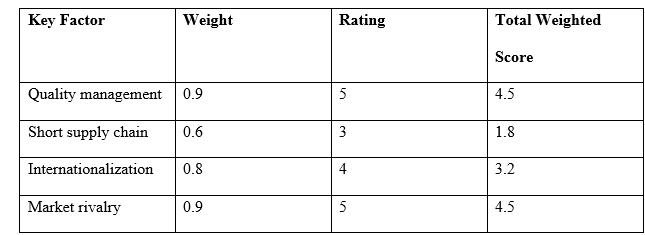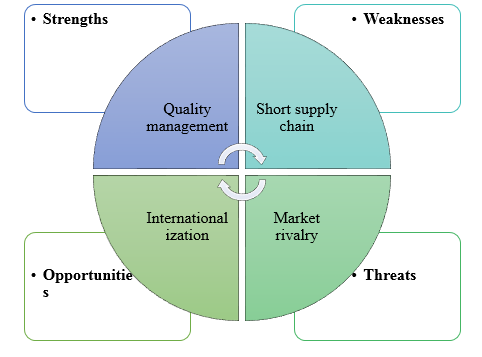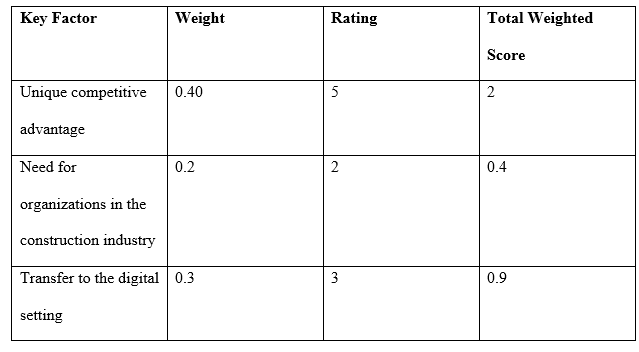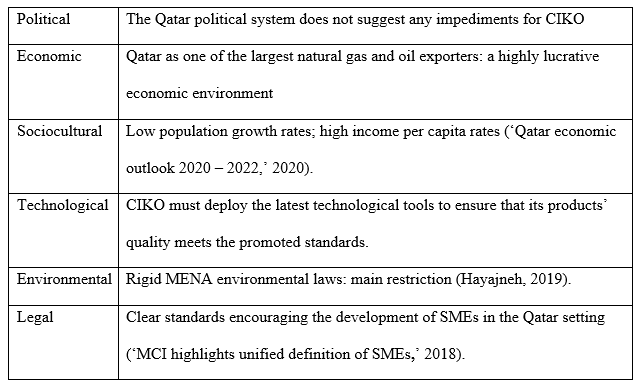Introduction
Expanding into new markets and trying to gain a voice within the global business community is always a challenge for a small or medium (SME) organization. Due to the limitations that the SME structure suggests, primarily, the restricted number of resources, the expansion process requires a meticulous analysis and a cautious strategy for entering a new and larger market space. For CIKO Middle East, a company that has warranted perfect reputation in the Qatar construction industry, the time has come to consider targeting new markets (McCormick and Somaya, 2020). However, due to the high competition and the lack of a clearly delineated competitive advantage that could be used as a part of its brand identity, CIKO will need a better-defined promotion framework to integrate into the global context successfully.
Company Description
CIKO Middle East is a SME located in Qatar and operating in the construction industry. CIKO Middle East was established in 2006, yet has not grown significantly since then, preferring to stay within its SME boundaries and still containing only 8 to 15 employees (‘CIKO Middle East,’ 2021). Nevertheless, the company has quickly inched its way into the Qatar market and climbed to its top due to the stringent quality standards and harsh control measures that ensure the product of the finest quality (Miller and Yang, 2016). Company Assessment
Internal
Table 1. IFE Matrx

SWOT

CIKO’s current performance is very impressive due to the firm’s commendable approach to quality management. Specifically, as the SWOT analysis above indicates, the organization has been prioritizing quality management, which has led to its statewide recognition.
Competitive Advantage
The emphasis on quality and the meticulous choice of techniques for selecting raw materials presently constitutes most of the company’s competitive advantage. Particularly, for CIKO to succeed in the global construction market, it is most reasonable to focus on developing the current competitive advantage, namely, the company’s ability to locate rare raw materials and produce the chemicals and construction tools that have increased efficiency (Widyanty et al., 2020).
EFE Matrix
To assess CIKO’s ability to function in the global setting, it is necessary to evaluate its internal characteristics, which can be accomplished by introducing the EFE matrix.
Table 2. EFE Matrix

With the weighted score of 2, the described threat should be addressed immediately by developing CIKO’s current competitive advantage (Hoe and Mansori, 2018). In turn, the organization’s main strength, namely, its approach toward quality management and the focus on using unique raw materials, constitutes sufficient basis for a competitive advantage.
PESTEL Analysis
Table 3. PESTEL

Overall, CIKO currently enjoys tremendous success in Qatar market. Moreover, its competitive advantage allows CIKO to consider further expansion. However, the company is yet to consider how to update its supply chain to meet the demands of the global market.
CIKO MIDDLE EAST’s Market Entry Strategy
The choice of entering the global economic environment should not be taken lightly by any means since it entails a hoard of risks for an unprepared company. The stakes are particularly high for SMEs, which have a limited range of resources and, therefore, need active support form partners and investors (Vahlne, 2020). Therefore, for CIKO, the choice of entering the global construction market must be well-weighted and grounded in a meticulous analysis of the possible prognoses.
Overall, the chances for CIKO to succeed as a result of internalization and entering the global economy are very high. Having become the top company in the Qatar construction and chemicals industry, CIKO is likely to advance in the global market quite promptly as well. Specifically, CIKO has a unique advantage to boast in the global market. Having a unique approach toward obtaining resources and managing product quality, CIKO will be able to attract new customers in the global market with its unparalleled quality and customer care (Schweizer, 2012).
Moreover, it is worth noting that the global economic environment requires compliance with the preset standardization criteria. In turn, due to the established quality framework, CIKO is unlikely to have any issues with the standardization task. Specifically, the situation in which the “conflict arises between personal cultural values and local culture,” as Apetrei et al. (2015, p. 1521) put it, are highly unlikely to occur. Therefore, CIKO can be expected to succeed quickly in the global economy, expanding and gaining new customers. For this reason, internationalization and the process of entering the global market must commence at CIKO immediately.
Market Strategy
To advance in the global construction market, CIKO will need to build its marketing framework based on the idea of quality and customer-oriented services. Additionally, it is highly recommended that CIKO should explore the opportunities of digital marketing. Thus, the company will establish a quick an effective link with potential partners, simplifying its B2B framework.
Market Assessment
When evaluating the target market, namely, the global construction and chemicals industry setting, one should note the presence of high competition and the existence of strong leaders that are unlikely to yield their positions. The construction market can be described as a thriving environment with long-stablished leaders and rather tight competition (Boersma, et al. 2003).
Marketing Mix
In order to advance in the global construction and chemicals market, CIKO will need to focus on marketing its quality and attention to customers’ needs, particularly, with regard to the customization options, as its primary advantage.
Price
Since CIKO will brand itself as the company offering the products and services of the highest quality, settling for a low-price strategy will be unreasonable. However, CIKO leaders will also have to take into account the fact that the global construction and chemicals industry has already been dominated by corporate giants such as BASF SE and Pidilite Industries Ltd., who offer reasonable pricing (Hayajneh, 2019). Therefore, CIKO will need to minimize the effects of its high pricing with saving options for customers, such as different discount types (for instance, seasonal discounts, discounts for frequent customers, and so on), membership cards, and similar techniques that will show CIKO’s willingness to compromise.
Promotion
As emphasized above, CIKO must us its superior quality as the key selling point in its promotion strategy. Specifically, the company must emphasize that it has a unique source of raw materials that allows maintaining unprecedented product quality and provide reasonable customizing options to buyers.
Physical Environment
In turn, the physical environment of the marketing process will be minimized to enhance the effects of the digital marketing techniques.
People
Although CIKO will seek to interact primarily with other organizations, following the B2B framework in its management of the corporate strategy, it will need an elaborate and culturally sensitive approach to communicating with its key stakeholders. Namely, CIKO will need to target organizations functioning in the agricultural context, including both companies producing agricultural products and those that sell chemicals to individuals, namely, farmers (Humphrey et al., 2020). Additionally, CIKO will need to consider the end customer, namely, the people that will use the products in question. Seeing that CIKO will function primarily in the agricultural sector, customer characteristics such as increased focus on the importance of sustainable development and resource usage (Sahebi et al., 2015). Thus, CIKO will have to brand its product with the current trend for environmentalism as the key characteristic of the target customers in mind. Additionally, the importance of transparency not only for customers, but also for people in the agriculture industry, in general, must be acknowledged so that CIKO could enter the global market successfully.
Finally, when developing the marketing strategy, the company will need to consider the crucial effects that the understanding of key cultural dimensions plays in creating a strong reputation for a company as a trustworthy and relatable firm in the global context. According to aaa, applying Hofstede’s framework of cultural dimensions to the notion of internationalization, a company must balance carefully between catering to culture-specific needs of its intended demographic while also retaining its unique flair and cultural markers. For CIKO, the specified requirement will mean that the company will have to use general culture markers as the proxy for conveying its essential values and appealing to the global demographic (Soares et al., 278). Out of the cultural markers, CIKO’s leaders may need to consider “class structure, language, context (low/high), interpersonal relationships, needs hierarchy, role of the sexes, role of children, territoriality, temporality, learning, work ethic” (Soares et al., 2007, p. 278), specifically in order to build a homogenous promotion campaign that will lead to creating a strong and relatable brand.
Product
In turn, when considering the product and especially the brand image that CIKO will have to introduce to the global audience, one must focus on representing the organization primarily as the provider of authentic and exclusive high-quality services. Due to the uniqueness of the raw materials and the lack of the available substitutions, the chemicals that CIKO provides must be represented as a one-of-a-kind opportunity that the target audience must not miss. Therefore, CIKO should make several crucial steps in representing its product to the target market. First, the company must ensure that it lists the full range of services and goods that it has to offer, including “Concrete and Mortar Admixtures, Waterproof Coatings, Grouts, Floor Coatings & Systems, repair Materials, Adhesives & Bonding Agents,” as the current list of its services states (CIKO Middle East, 2021). Additionally, the company must emphasize the role that the selection of raw materials plays in the enhancement its products quality.
Process
The task of marketing the organization’s product and attracting the target companies will imply aligning CIKO’s production with its financial strategy and its communication framework, as well as the Research and Development. Namely, it will be crucial to implement the following steps in order to ensure that the information about the company and it product reaches the target audience.
- Investing in the Research and Development function of the organization to keep innovative solutions emerging;
- Diversifying the existing product to address specific needs of the target population;
- Creating a brand image and brand concept rooted in the idea of exclusive quality and the focus on customers’ specific needs (Chin et al., 2018);
- Exploring the available routes for advertising the product (particularly, using social media);
- Creating product value by establishing the uniqueness and high quality of the raw materials used of the manufacturing process;
- Outlining the environmentally friendly nature of the product and the associated services;
- Launching a digital application for simplifying the process of interacting with the company and its products (Warokka et al., 2020).
- Building a communication channel for receiving feedback from customers, suppliers, business partners, local organizations, community members, and other stakeholders (Amin and Priansah, 2019).
The described steps are expected to support CIKO in its endeavor at establishing a strong and powerful presence in the global construction market.
Place
Finally, the issue of place must be considered thoroughly before launching CIKO in the global construction market. Namely, the company will need to find the unique location where customers will be able to purchase the product (Raja, 2020). Since CIKO will strive to enter the digital setting first, the company will need to consider sites such as Amazon and similar companies for product delivery as the possible place for selling its products. Additionally, CIKO will introduce the opportunity to purchase its chemicals at its official site (Sari, 2019). Thus, the organization will control the efficacy of product and service delivery and ensure that the ordered goods are provided in a timely manner.
Early Exposure
Given the described characteristics of CIKO, it will be reasonable to give the organization an early start to adjust to the specifics of the global market setting and attract as many customers as possible. Thus, CIKO will be able to cement its presence in the global construction market for a substantial time period. For this reason, the early exposure framework should be considered as the most effective solution to the problem at hand. With the early exposure technique, CIKO will be able to garner the attention of as many target organizations as possible, using the available time to improve its supply chain and extend it to include now partners. Thus, CIKO will embrace global possibilities without disrupting the established supply chain significantly. Moreover, the use of early exposure will help CIKO to create a brand name for itself, thus, warranting the high prices that it is about to set. However, it should be noted that early exposure may lead to creating preset expectations that the company may fail to meet in the future.
Intelligence Network
In addition to the proposed approach toward entering the global marker, CIKO must consider the application of the intelligence network. The described tool serves as the most effective and expeditious way of obtaining vital information about the target economic environment, which is truly priceless in the global construction market given the importance that the ability to manage information presently has (Alamri, 2018). By building an intelligence network, CIKO will be able to incorporate different types of data into its analysis, connecting the specified information types into a system in which every item will interact with the rest, thus providing the basis for accurate forecasts (Husgafvel et al., 2018). The described technique will imply including the data associated with key market trends, as well as the data associated with technological changes and financial alterations (Durana et al., 2019). Though the proposed approach might seem disjointed, it will provide the foundation for informed decision-making due to the connectivity between different information types: “So-called ‘‘teardown’’ reports provided technical information on the inputs used in the assembled product (such as the hard-disk drive, display and memory) as well as their market prices” (Buckley et al., 2020, p. 8). Therefore, intelligence networks must be deemed as a legitimate approach to building an entry strategy for CIKO. However, the use of intelligence networks will require significant costs, which may reduce CIKO’s chances for rapid success.
Reference List
Alamri, A. M. (2018) ‘Strategic management accounting and the dimensions of competitive advantage: testing the associations in Saudi industrial sector’, International Journal of Academic Research in Accounting, Finance and Management Sciences, 8(2), pp. 48-64.
Amin, M. and Priansah, P. (2019) ‘Marketing communication strategy to improve tourism potential’, Budapest International Research and Critics Institute-Journal (BIRCI-Journal), 2(4), pp. 160-166.
Apetrei, A., Kureshi, N. I. and Horodnic, I. A. (2015) ‘When culture shapes international business’, Journal of Business Research, 68(7), pp. 1519-1521.
Boersma, M. F., Buckley, P. J., and Ghauri, P. N. (2003) ‘Trust in international joint venture relationships’, Journal of Business Research, 56(12), pp. 1031-1042.
Buckley, P. J., Strange, R., Timmer, M. P. and de Vries, G. J. (2020) ‘Catching-up in the global factory: Analysis and policy implications’, Journal of International Business Policy, 1-28.
Chin, T. A., Lai, L. Y. and Tat, H. H. (2018) ‘Determinants of Brand image and their impacts on purchase intention of grab’, Journal of Arts & Social Sciences, 2(1), pp. 26-36.
CIKO Middle East (2020) Web.
CIKO Middle East (2021) Web.
Durana, P., Kral, P., Stehel, V., Lazaroiu, G. and Sroka, W. (2019) ‘Quality culture of manufacturing enterprises: a possible way to adaptation to industry 4.0’, Social Sciences, 8(4), p. 124.
Hayajneh, A. Z. (2019) ‘Filling the gaps: proposed review to improve Qatar environmental law’, Journal of Law, Policy and Globalization, 91, pp. 8-16.
Hoe, L. C. and Mansori, S. (2018) ‘The effects of product quality on customer satisfaction and loyalty: Evidence from Malaysian engineering industry’, International Journal of Industrial Marketing, 3(1), p. 20.
Husgafvel, R., Linkosalmi, L., Hughes, M., Kanerva, J. and Dahl, O. (2018) ‘Forest sector circular economy development in Finland: A regional study on sustainability driven competitive advantage and an assessment of the potential for cascading recovered solid wood’, Journal of Cleaner Production, 181, pp. 483-497.
Humphrey, J., Todeva, E., Armando, E. and Giglio, E. (2020) ‘Global value chains, business networks, strategy, and international business: Convergences’, Revista Brasileira de Gestão de Negócios, 21, pp. 607-627.
McCormick, M. and Somaya, D. (2020) ‘Born globals from emerging economies: Reconciling early exporting with theories of internationalization’, Global Strategy Journal, 10(2), pp. 251-281.
‘MCI highlights unified definition of SMEs’ (2018) Qatar Online News, Web.
Miller, D. J., and Yang, H. S. (2016) ‘The dynamics of diversification: Market entry and exit by public and private firms’, Strategic Management Journal, 37(11), pp. 2323-2345.
Qatar economic outlook 2020 – 2022 (2021) Web.
Raja, P. (2020) ‘Environmental management system (EMS) and green marketing mix (7Ps) for hotel sustainable industrial performance: a conceptual model’, Environmental Management, 29(7s), pp. 3724-3732.
Sahebi, H., Nickel, S. and Ashayeri, J. (2015) ‘Joint venture formation and partner selection in upstream crude oil section: goal programming application’, International Journal of Production Research, 53(10), pp. 3047-3061.
Sari, P. R. J. (2019) ‘Digital marketing as promotion on Bali jeep adventure products’, International Research Journal of Management, IT and Social Sciences, 6(5), pp. 204-209.
Schweizer, R. (2012) ‘The internationalization process of SMEs: A muddling-through process’, Journal of Business Research, 65(6), pp. 745-751.
Soares, A. M., Farhangmehr, M. and Shoham, A. (2007) ‘Hofstede’s dimensions of culture in international marketing studies’, Journal of Business Research, 60(3), pp. 277-284.
Vahlne, J. E. (2020) ‘Development of the Uppsala model of internationalization process: From internationalization to evolution’, Global Strategy Journal, 10(2), pp. 239-250.
Warokka, A., Sjahruddin, H., Sriyanto, S., Noerhartati, E. and Saddhono, K. (2020) ‘Digital marketing support and business development using online marketing tools: an experimental analysis’, International Journal of Psychosocial Rehabilitation, 24(1), pp. 1181-1188.
Widyanty, W., Daito, A., Riyanto, S. and Nusraningrum, D. (2020) ‘Gaining a competitive advantage through strategic human resource management in Indonesian construction industry’, Management Science Letters, 10(9), pp. 2021-2028.
